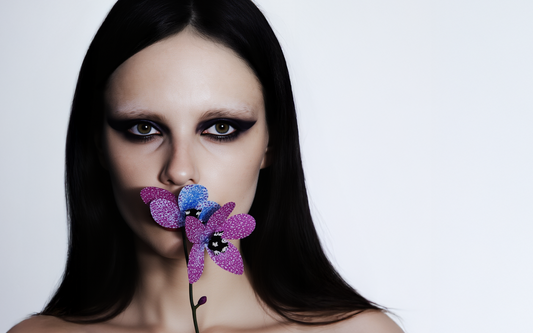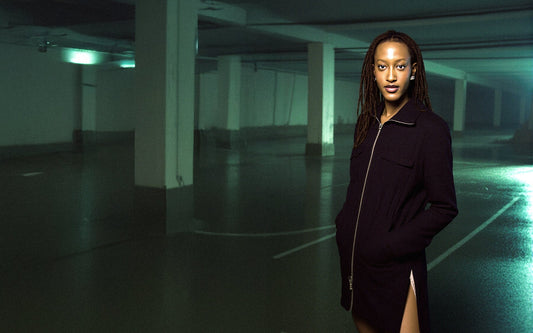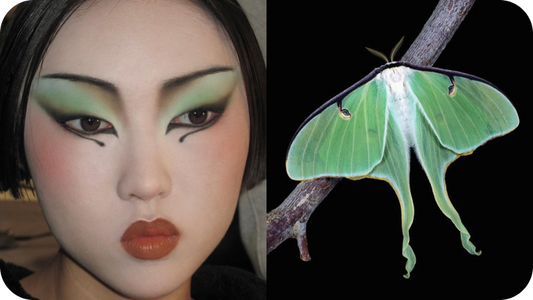Independent curator, writer, and editor Günseli Yalcinkaya sat down with one of STUDIO HALIA’s latest partner artists, photographer Erica Snyder, to discuss how AI is reshaping the creative process, the emotional tension between analog and artificial, and what it means to make art that still feels human in a hyper-digital world.
Known for her cinematic portraits and collaborations with Casablanca, Versace, Teen Vogue, and Highsnobiety, Snyder made her first foray into generative AI by partnering with STUDIO HALIA on an intimate in-person experience at WSA last month.

Credit: FACE VALUE - Erica Snyder X STUDIO HALIA
In this conversation, Yalcinkaya, whose writing often probes the strange intersections of art and emerging technology, and Snyder unpack the stakes of this new collaboration: from algorithmic aesthetics and to the rising challenge of producing images that feel intentional in an era defined by visual saturation.
GY: What’s your experience been like using AI so far?
ES: My experience has been extremely limited. In my day-to-day experience, I do use Chat GPT – I'll ask it what temperature to cook my salmon at, what my astrology reading is, or mundane tasks. I've never actually used it in terms of art or photography at all, so this is my first experience.
GY: What was the initial concept for your collaboration with STUDIO HALIA?
ES: STUDIO HALIA asked me to come up with three concepts. One of the concepts that I came up with goes back to when I first started photography. I only shot landscapes and I wanted this experience to kind of go back to my roots of starting photography, to incorporate that into the experience.
 Credit: Erica Snyder X STUDIO HALIA
Credit: Erica Snyder X STUDIO HALIA
GY: What was the process like?
ES: I gave STUDIO HALIA 12 images that I had taken back in 2016, which we used as the input to then bring models into the images, to create these cinematic portraits of people. It's interesting because they have almost like an eerie AI element to them. But there's also this element of nostalgia that's incorporated into the end results, because of the landscapes that we decided to use.
I was most surprised by the variables of the AI output and how many iterations were necessary to come close to an image that resembled something similar to my own work. It was also exciting to see the response to the images, the excitement, dismay and curiosity it sparked from the participants. Going through the process also eased my fear that AI will fully be able to ‘replace’ my profession.
GY: There’s a nice interplay between the film photography inputs as a more traditional medium and the AI itself, it’s a juxtaposition that you rarely see.
ES: The experience was very interesting. I was most surprised by the variables of the AI output and how many iterations were necessary to come close to an image that resembled something similar to my own work. It was also exciting to see the response to the images, the excitement, dismay and curiosity it sparked from the participants. Going through the process also eased my fear that AI will fully be able to ‘replace’ my profession.
GY: What are some creative applications of AI that might be useful for creatives?
ES: I've seen other photographers use it if they have an idea, where you have a client asking for a mood board, and you’re looking for an image that doesn’t exist yet. This gives the client a clearer picture of what they're going to do on set. In terms of that, it seems incredibly useful in explaining what's in your head and getting it into a visual form.
GY: What are your hopes for AI within fashion, in particular?
ES: My hope is that AI will be used as a tool to facilitate artists to explore things, but not as the end product. The industry right now has gotten so crazy, especially in advertising, just even with the evolution of TikTok over the past couple years and brands turning to influencers to sell a product, instead of investing in traditional ad campaigns. I've seen budgets rapidly decrease, which is already scary. With the introduction of [generative] AI, I'm hoping the industry doesn't view it as another way to cut down on spending, and still has a product to show for it.

Credit: FACE VALUE - Erica Snyder X STUDIO HALIA
Every time a new technology is invented, people just take a while to adjust. I think it's the fear of the unknown and its potential versus our human ability. I think we're almost predispositioned to be adverse to things that we don't understand.
GY: Fashion and beauty are both industries that typically slow adopters of emerging technologies. How do you see the relationship between fashion and tech? Is this something that you’ve also observed?
ES: That's a really great question. I think there's always been a base fear of technology throughout the centuries. Every time a new technology is invented, people just take a while to adjust. I think it's the fear of the unknown and its potential versus our human ability. I think we're almost predispositioned to be adverse to things that we don't understand. And yeah, the fashion industry is a slow moving beast.
Everyone's worried about their own financial security right now and people want to retain their personal value. We've seen so many people's jobs become replaced by technology, and this industry is so brutal as it is, so to see something else coming into this space that you're in is terrifying.
GY: Have you picked on any fashion trends or predictions for the future?
ES: It's hard to say, because I feel like there's two different camps right now. Some people are embracing AI and using it to generate or enhance their images. There's also a big movement back to film. I think people are pushing against it [AI], looking for that rawness and analog elements. Being able to identify that something is real. It will be interesting to see where it ultimately leads to.
 Credit: Erica x Office Magazine NYC
Credit: Erica x Office Magazine NYC
GY: I agree with you, there’s definitely been this yearning for a return to craft in recent years, which reflects what you’re saying about film photography. I think it also goes back to this idea of creativity versus pragmatism. On one hand, AI is great if you’re an independent artist looking to cut some costs and do more things without necessarily having the experience. But on the other hand, there’s so much lazy AI output, it’s so easy for images to end up looking mid.
ES: I think photography in general these past couple of years has been just mid across the board. It's been really uninspiring. For some reason everybody has been like, we want to be back in the studio, minimal set design. The lighting is boring, the design is boring. What they're asking of models right now is also uninspiring. Everything feels very safe.
GY: Do you think that's down to social media and censorship? Maybe there's something about the Attention Economy that’s making everything feel safe, like in order to succeed in the algorithm game, you have to hit a certain vibe.
ES: I can't remember where I heard this, but someone was talking about Gen Z growing up on the internet and how this surveillance culture leans to self-surveillance. How if you fuck up or you do something that's cringe worthy, it's imprinted in the internet forever. I think you're right, like people are afraid to take risks, because if it doesn't go well, then it pushes you down the algorithm, and that might hurt you in the long run.
 Credit: Erica Synder
Credit: Erica Synder
GY: You mentioned you started shooting photographs around 2015-16, which was around the same time that Instagram was really kicking off. How have you felt the effects of social media impact your practice over the years?
ES: Instagram was a different beast back then. But I was never afraid of publishing my work, so I would shoot and post it onto Instagram. The algorithm was obviously so different back in those days and there were also these very niche communities, like there were a few photographers really into landscape photography, and I was one of them. Whatever the algorithm was doing really started to push my work, and shortly after, I got some recognition from magazines and people reaching out. It really worked in my favor to get my name out there, almost instantaneously.
But when I started to move my work away from landscapes, I got into portraiture and was shooting musicians – it was really interesting, because all the people who had followed my work for landscapes suddenly were no longer interested, which I think can really discourage an artist. But, I was like, I don't give a fuck. I'm not pandering because I want the attention or the likes. But I think it can really discourage people when they try and switch things up or become interested in something else, especially right now when Instagram used to favor actual photography back in like 2016 now we're seeing like influencers and, yeah, that's what’s really being pushed to the forefront.
-
Günseli Yalcinkaya is an independent curator, writer and editor with a particular focus on emerging technologies and internet culture. She is a Contributing Editor at Dazed Magazine, and a contributor at 032c, Art Review and Spike Art. You can follow her work here.
Featured Image Credit: Massimbi Ericka Kabera / FaceValue Experience by STUDIO HALIA and Erica Snyder
 Log in
Log in



